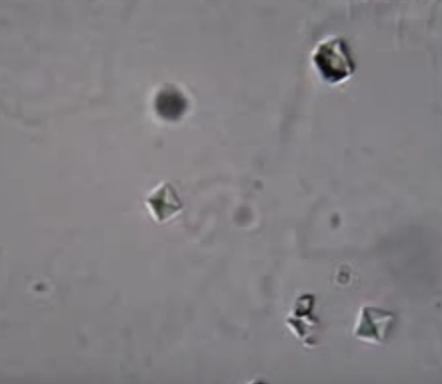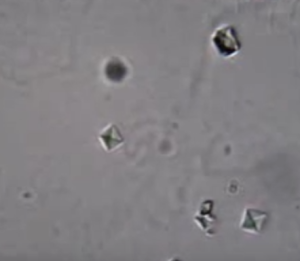Medically termed as urolithiasis or crystalluria, crystals in cat urine is a condition classified as an FLUTD or Feline Lower Urinary Tract Disease, it was previously categorized as FUS/Feline Urinary Syndrome. The condition is serious and tend to occur in 0.5 to 1 percent of cats. Male cats are at increased risk to developing crystals as their urethra is more constricted as compared to urethra in a female cat. Crystals can occur in different parts of the urinary system such as the bladder, kidneys, urethra, or the ureters and may block the free flow of urine.
Crystals in cat urine is not just an extremely painful condition, but also life-threatening. Hence, affected cats should be given immediate and emergency medical treatment.
Symptoms of crystals in cat urine
Cats affected by crystals in urine may experience continuous discomfort and varied behavioral changes. Some of the accompanying signs and symptoms are listed below:
- Straining when passing urine
- Specks of blood in cat urine
- Nil or 2 to 3 drops of urine may get eliminated at a time
- Affected cats may stop using the litter box all of a sudden
- Affected cats may cry around the litter box, an indication that they are unable to urinate even when they want to
- Loss of appetite
- Vomiting
- Passing urine many times a day
- Irritability, pain, and enlargement of the bladder
- Excessive licking of the genital area
- Instead of the litter box, affected cats may pass urine in other areas
- Excessive buildup of urine due to crystals can eventually result in kidney failure and death of the cat.
Causes
Some of the common causes of crystals in cat urine are discussed below:
- Feline Idiopathic Cystitis/FIC: It is the most prevalent cause of crystals in cat urine and is observed in more than 50 to 60 percent of cats with crystalluria. A glycosaminoglycan called GP-51 lines the bladder in cats and guards them from bacterial infections and other harmful qualities of urine. Cats with cystitis tend to suffer from removal of minor amounts of GP-51, which in turn exposes the bladder lining to harmful effects and infections. Affected cats subsequently exhibit pain in pelvic region, urinary bladder irritation, and FLUTD.
- The diet: Crystals in cat urine are primarily caused due to the levels of urine pH and the mineral components in urine. Urine pH levels are determined by the diet of the cat, whether it ends up eating all through the day or whether it is given meals at specific timings.A proper diet, with not excessive magnesium content, that is administered at specific times will not only help maintain the levels of urine pH and mineral concentration in urine, but will also help prevent the onset or the worsening of crystals in cat urine.
- Urethral blockage: It is a life-threatening condition that can cause death of the cat if not immediately treated. Occurrence of urethral plugs is the major cause of urethral obstruction. These plugs consist of increased quantities of protein that are combined with mineral. Some of them consist of rounded debris, tissue pieces, and blood cells. It is also possible for the plugs to main contain just proteins or just mineral stones.
- Uroliths: It is the medical term used to describe the presence of urinary stones. The most common types include struvite or calcium oxalate crystals. Around 15 to 20 percent of cats with crystals in urine tend to suffer from an underlying case of uroliths. An ultrasound is used to determine the type of urinary stone after which relevant treatment options are prescribed by the vet. In most cases, a vet will suggest diet changes that can help dissolves the stones and alleviate crystals in cat urine.
- Stress: Increased stress can also trigger formation of crystals in cat urine. Stress can occur due to the surroundings of the animal/pet or because of some ailment. Ensure that the cat is stress-free, cheerful, and devoid of any trauma to avoid crystalluria.
- Cancer: Urinary tract tumors and cancers can also increase the susceptibility to occurrence of crystals in cat urine.
- Other causes: Crystalluria in cats may also occur due to UTIs/bacterial infections, genetics, side effects of medicines, urethral trauma, and congenital or anatomical defects of the bladder, urethra, or other parts of the cat’s urinary system.
Treatment
Crystals in cat urine can be treated in the following ways:
- Crystalluria in cats is an extremely painful condition. Use carprofen or other anti-inflammatory drugs for alleviation of pain
- Potassium citrate can be used to treat oxalate crystals; struvite crystals can be treated with urinary acidifiers; and the glycosaminoglycan coat that lines the bladder can be strengthened with glucosamine supplements.
- Antispasmodics can be given to relax the urethra and bladder walls so as to aid the passage of urine and reduce pain.
- Crystals in cat urine caused due to bacterial infection can be treated with antibiotics.
- Ensure that you cat drinks as much water as possible. It will facilitate urine dilution as well as help prevent future cases of crystals in cat urine.Crystals and other debris present in the urinary tract can thus be easily flushed out.
- Ensure that the cat is given a balanced diet, including canned diets. Instead of dry and wet cat foods, you may also opt for natural raw meat. This will ensure that the urine pH levels are maintained at more natural levels. Provide little amounts of food to your pet many times a day; such changes in feeding habits is especially helpful if the cat is used to one or 2 times a day.
- Changes in diet is often dependent on the type of crystals in cat urine. Hence, it is important to consult a vet before making any modifications in diet.
- Cats can experience increased stress due to causes such as a new cat in the house, sharing the litter box or food, etc. Hence, ensure a comfortable environment, separate items, and personal space to prevent stress and crystals in cat urine. Sedentary cats are more vulnerable to developing crystalluria than an active one. You can increase your cat’s level of physical activities by using lasers, toys, and providing a scratch post.
- Amitriptyline, an anti-anxiety medication may also be used to alleviate stress.
- In severe cases, crystals in cat urine may be physically removed via surgery.

